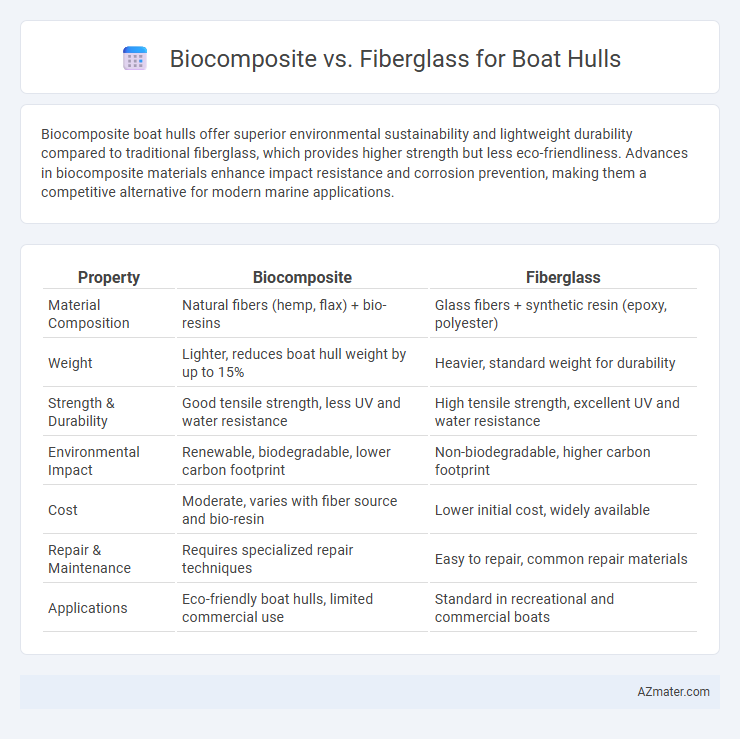Biocomposite boat hulls offer superior environmental sustainability and lightweight durability compared to traditional fiberglass, which provides higher strength but less eco-friendliness. Advances in biocomposite materials enhance impact resistance and corrosion prevention, making them a competitive alternative for modern marine applications.
Table of Comparison
| Property | Biocomposite | Fiberglass |
|---|---|---|
| Material Composition | Natural fibers (hemp, flax) + bio-resins | Glass fibers + synthetic resin (epoxy, polyester) |
| Weight | Lighter, reduces boat hull weight by up to 15% | Heavier, standard weight for durability |
| Strength & Durability | Good tensile strength, less UV and water resistance | High tensile strength, excellent UV and water resistance |
| Environmental Impact | Renewable, biodegradable, lower carbon footprint | Non-biodegradable, higher carbon footprint |
| Cost | Moderate, varies with fiber source and bio-resin | Lower initial cost, widely available |
| Repair & Maintenance | Requires specialized repair techniques | Easy to repair, common repair materials |
| Applications | Eco-friendly boat hulls, limited commercial use | Standard in recreational and commercial boats |
Introduction to Boat Hull Materials
Boat hull materials significantly impact performance, durability, and environmental footprint, with biocomposites and fiberglass being prominent choices. Biocomposites combine natural fibers like flax or hemp with bio-based resins, offering sustainable alternatives with reduced weight and improved impact resistance. Fiberglass, composed of glass fibers embedded in polyester or vinyl ester resin, remains industry-standard due to its high strength, cost-effectiveness, and ease of repair.
Overview of Biocomposites in Boat Building
Biocomposites in boat building combine natural fibers like flax, jute, or hemp with bio-based resins, offering a sustainable alternative to traditional fiberglass hulls. These materials exhibit comparable strength and weight characteristics while significantly reducing environmental impact through biodegradability and lower carbon footprint. The integration of biocomposites enhances boat performance by improving vibration damping and resistance to water absorption compared to conventional fiberglass composites.
Understanding Fiberglass and Its Role in Marine Applications
Fiberglass is a composite material composed of glass fibers embedded in a resin matrix, widely used for boat hulls due to its excellent strength-to-weight ratio and corrosion resistance. In marine applications, fiberglass provides durability, impact resistance, and ease of repair, making it a reliable choice for both recreational and commercial vessels. Its ability to withstand harsh marine environments while maintaining structural integrity has established fiberglass as a standard material in boat construction.
Environmental Impact: Biocomposite vs Fiberglass
Biocomposite boat hulls significantly reduce environmental impact by utilizing natural fibers such as flax or hemp combined with bio-based resins, offering enhanced biodegradability and lower carbon footprints compared to traditional fiberglass. Fiberglass production relies on energy-intensive manufacturing and non-renewable petrochemical resins, leading to higher greenhouse gas emissions and challenging end-of-life disposal due to non-biodegradability. Choosing biocomposite materials supports sustainable boatbuilding with reduced ecological damage, improved recyclability, and alignment with green energy initiatives.
Strength and Durability Comparison
Biocomposite boat hulls offer comparable strength to fiberglass while providing enhanced environmental benefits through sustainable materials like natural fibers and bio-resins. Fiberglass exhibits superior resistance to impact and long-term wear, maintaining structural integrity under harsh marine conditions and prolonged UV exposure. Despite slightly lower durability, biocomposites excel in weight reduction and flexibility, making them a viable alternative for lightweight, eco-friendly boat construction.
Weight and Performance Differences
Biocomposite boat hulls offer significant weight reduction compared to traditional fiberglass, enhancing fuel efficiency and maneuverability. Fiberglass hulls, while heavier, provide proven durability and resistance to impact, but often result in slower acceleration and higher fuel consumption. The lighter biocomposite materials contribute to improved speed and handling, making them favorable for performance-focused vessels.
Maintenance and Longevity Factors
Biocomposite boat hulls offer superior resistance to rot and corrosion compared to fiberglass, reducing maintenance frequency and costs over time. Fiberglass hulls require regular gelcoat repairs and are prone to osmotic blistering, which can compromise longevity without consistent upkeep. The environmental benefits of biocomposites align with durable materials science, providing extended lifespan through natural fiber reinforcement and eco-friendly resin systems.
Cost Analysis: Biocomposite vs Fiberglass
Biocomposite boat hulls typically incur higher upfront costs due to raw materials like natural fibers and bio-resins, which remain less commoditized compared to fiberglass components. Fiberglass hulls benefit from established manufacturing techniques and economies of scale, resulting in lower initial production expenses and more competitive market pricing. Long-term cost considerations for biocomposites include potential savings from enhanced environmental compliance and reduced disposal fees, contrasting with fiberglass's higher lifecycle environmental impact and associated regulatory costs.
Adoption and Trends in Boat Manufacturing
Boat manufacturers increasingly adopt biocomposite materials over traditional fiberglass due to environmental regulations and consumer demand for sustainable products. Biocomposites offer comparable strength with reduced weight and lower carbon footprints, accelerating their integration in hull production. Market trends reveal a steady rise in research and development investments aimed at improving biocomposite durability and cost-efficiency for broader industry adoption.
Future Outlook for Sustainable Boat Hull Materials
Biocomposite boat hulls, made from natural fibers and bio-based resins, offer significant environmental benefits by reducing carbon footprints and enhancing biodegradability compared to traditional fiberglass. Innovations in biocomposite technology aim to improve mechanical strength and durability, positioning them as a sustainable alternative as regulations tighten and consumer demand for eco-friendly vessels grows. The future of sustainable boat hulls hinges on the scalability and cost-effectiveness of biocomposites, fostering a transition away from fiberglass towards greener marine materials.

Infographic: Biocomposite vs Fiberglass for Boat Hull
 azmater.com
azmater.com